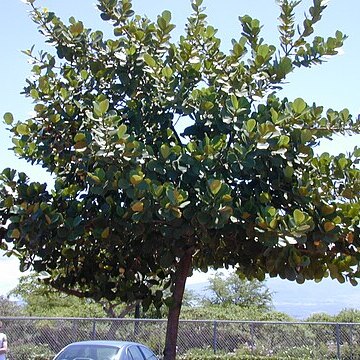Trees, shrubs, subshrubs or herbs, rarely climbers, mostly containing a yellow, orange or clear resinous latex, usually glabrous but occasionally with an indumentum of simple or stellate hairs. Leaves usually opposite, sometimes verticillate or alternate, simple, entire or very obscurely crenate, exstipulate, usually with glands and resin channels which are often translucent. Inflorescences terminal or axillary, 2-fid cymes, false racemes, panicles, fascicles or umbels or sometimes the flowers solitary. Flowers regular, often fleshy, hermaphrodite, dioecious or polygamous. Sepals (2–)4–5(–6 or more), imbricate, often decussate. Petals free, 4–5(–6 or more), imbricate or contorted, sometimes decussate. Stamens usually numerous, free or very often in fascicles or fused into groups, anthers usually with 2 thecae dehiscing by longitudinal slits; the outer fascicles are often sterile “fasciclodes”, frequently forming what is often called the disc, or are absent. Ovary superior, 1–several-locular, with parietal, axile, apical or basal placentation; ovules anatropous, l–? per locule; styles free or fused, sometimes very short or absent; stigmas or stigma-lobes mostly equal in number to the locules. Fruit a berry, drupe or septicidal (rarely loculicidal) capsule. Seeds arillate or not, without albumen, sometimes winged; embryo with cotyledons often very reduced
Trees, shrubs, (or vines outside Australia), often evergreen; hermaphrodite, polygamomonoecious or dioecious. Usually glabrous. Coloured, milky or clear resinous sap present in secretory canals or cavities. Leaves usually opposite (rarely whorled), sometimes decussate, simple, entire, usually exstipulate. Inflorescences terminal or axillary, flowers in cymes, panicles or solitary, bracteate. Flowers actinomorphic; perianth of sepals and petals or tepals; calyx 2–10-merous, lobes free or fused at base, imbricate, sometimes persistent in fruit; corolla 3–6 (–10)-merous, free, imbricate; tepals 4–8 (–12)-merous, free or connate at base. Stamens 4 to several hundred, free, basally connate in bundles sometimes partly adnate to petals (occasionally united in a ring in tribe Symphonieae, or sessile on a capitulum in Chrysochlamys); anthers basifixed, bilocular, dehiscent by longitudinal slits. Staminodes and pistillode often present, rudimentary to very well developed; ovary of 1–8(–21) carpels, superior, (1–) 2–many-locular with 1 to many ovules per locule; placentation axile or parietal; styles 1–5 free or partly connate, usually very short or absent; stigmas (3–) 4–16, lobed or entire. Fruit a berry or septicidal capsule, usually terete, sometimes winged or star-shaped in cross section. Seeds 1 to many, arillate, without endosperm.
Shrubs or trees [lianas], evergreen, <usually glabrous>. Leaves decussate [whorled], estipulate; petiole usually present; blade margins entire; <glandular canals not containing hypericin or pseudohypericin>. Inflorescences terminal, dichasial, thyrsoid, or corymbiform or flowers solitary. Pedicels absent or relatively stout. Flowers unisexual [bisexual], actinomorphic, hypogynous; sepals persistent, [2–]4[–14], imbricate or decussate; petals persistent [deciduous], [3–]6(–8)[–14], <without ventral scale>; [stamens distinct or fasciculate; <filaments nearly as wide as anthers>; anthers usually dehiscing longitudinally, sometimes locellate, <eglandular>]; pistils 1; ovary superior, 3–12-locular; placentation axile; ovules 1–6+ per locule, anatropous, bitegmic, tenuinucellate; styles absent [relatively short]; stigmas [3–]6–9(–12). Fruits capsular [berrylike, drupelike], dehiscence septifragal. Seeds arillate, embryo usually green, straight, <cotyledons minute [absent]>, endosperm absent.
Androecium basically of two whorls of stamen fascicles, the outer (antisepalous) one often sterile (fasciclodes) or absent, filaments variously united or free (when the androecium may appear polyandrous); antipetalous fascicles variously united or free, very rarely each one reduced to a single stamen
Ovary superior, 1–5-locular (rarely to 12-locular), placentation usually axile, sometimes ± parietal, loculi 1–?-ovulate; styles free, ± united or absent; stigmas equal in number to the loculi
Ovary sessile, superior, 1-to many-celled; ovules 1 to many, on the inner angle of the cells or erect from their base, rarely parietal (Allanblackia); stigmas various, sometimes radiating
Stamens mostly numerous, hypogynous, free or variously united in the lower part or into bundles opposite the petals; anthers 2-celled, opening lengthwise
Leaves opposite or rarely subopposite to alternate or whorled, simple, usually entire, exstipulate, containing various glandular secretions
Petals 4–5 (6 or more), free, usually convolute (sometimes imbricate or decussate, rarely absent), alternating with the sepals
Rudimentary ovary sometimes present in the male flower; staminodes often present in the female flower
Seeds often with an aril, without endosperm; embryo large; cotyledons often minute
Petals the same number, hypogynous, contorted or imbricate, very rarely subvalvate
Flowers actinomorphic, unisexual, polygamous or dioecious, rarely hermaphrodite
Trees, shrubs, woody climbers or perennial or annual herbs; juice resinous
Fruit a septicidal (rarely loculicidal) capsule or a berry or drupe
Seeds sometimes winged, carinate or arillate, without endosperm
Flowers actinomorphic, bisexual, dioecious or polygamous
Sepals (2) 4–5 (6 or more), quincuncial or decussate
Fruit dehiscent or not, sometimes large and globose
Leaves opposite, simple; stipules absent
Trees or shrubs, with resinous juice
Sepals 2–6; rarely more, imbricate

